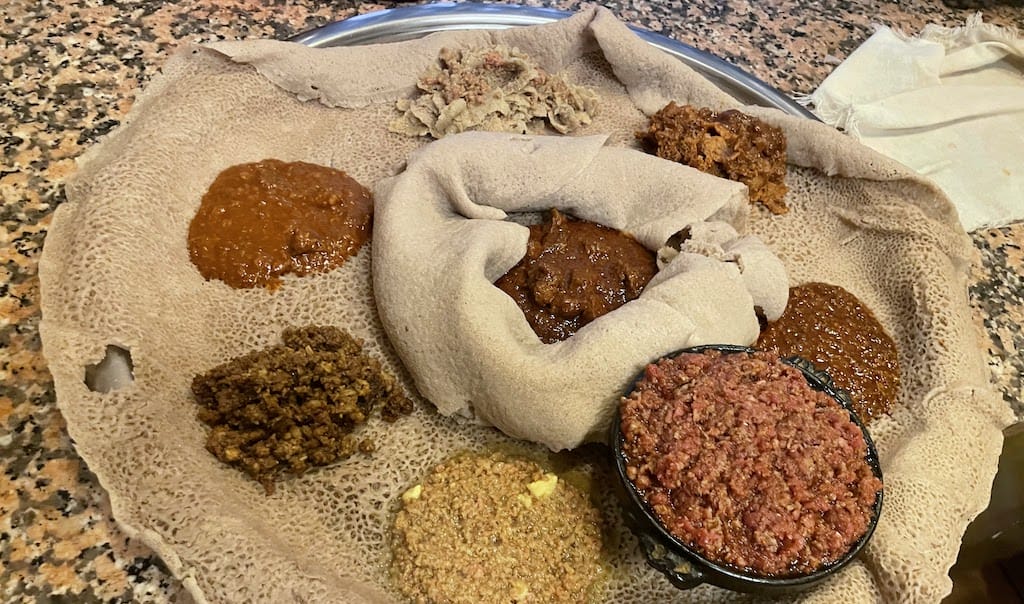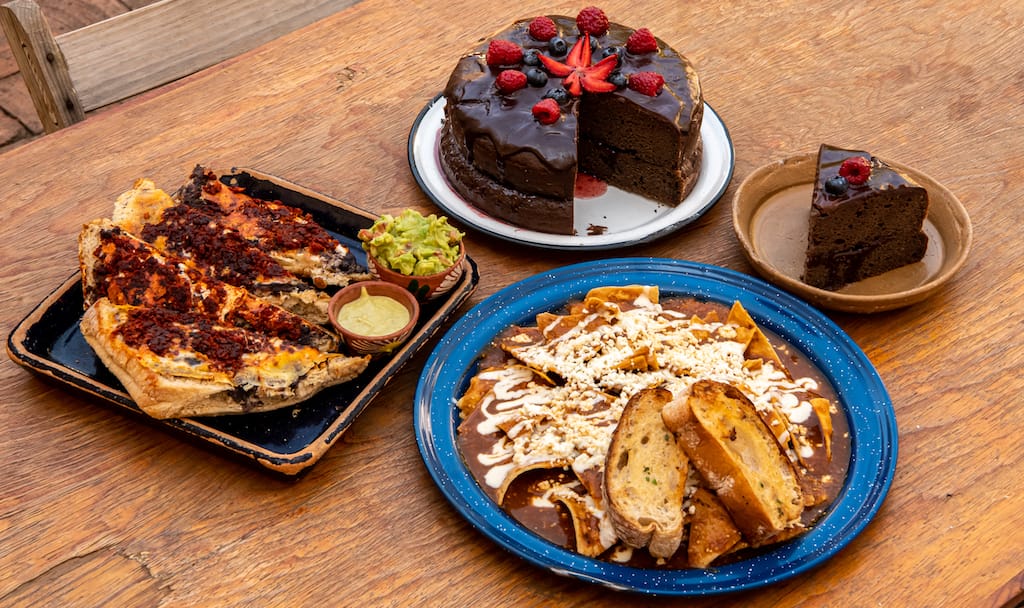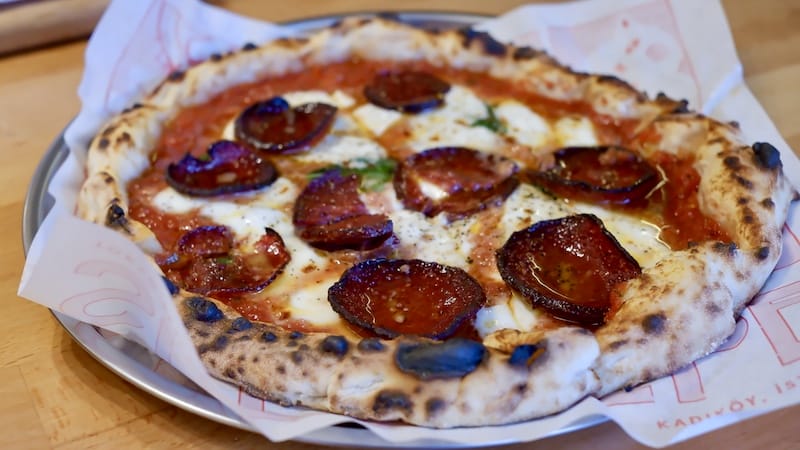A friend once said that God could never bring all of his people to one place. But then he visited the Aksaray neighborhood in Istanbul, a stone’s throw from Sultanahmet’s iconic mosques. Aksaray acts as both a landing point for new arrivals and a launching pad for those trying to make it to Europe. The neighborhood provides a culinary roadmap for the city’s immigrant communities and it teems with delicious diversity – with restaurants serving everything from Somali to Georgian fare.
Unlike more recent transplants, Ethiopians have been in the city for a long time. Take the old story of Beshir Agha, for example. Born in Ethiopia, he was brought as a slave to the Ottoman Empire but was eventually appointed Chief Harem Eunuch in Istanbul under Sultan Ahmed III in 1716, later becoming the third most powerful person in the palace.
But while the presence of Ethiopians in Istanbul is not new, their food is less well known. On a backstreet, with shops selling life jackets and sleeping bags, we visited the modest, ground-floor Ethiopian eatery known as Mesob.
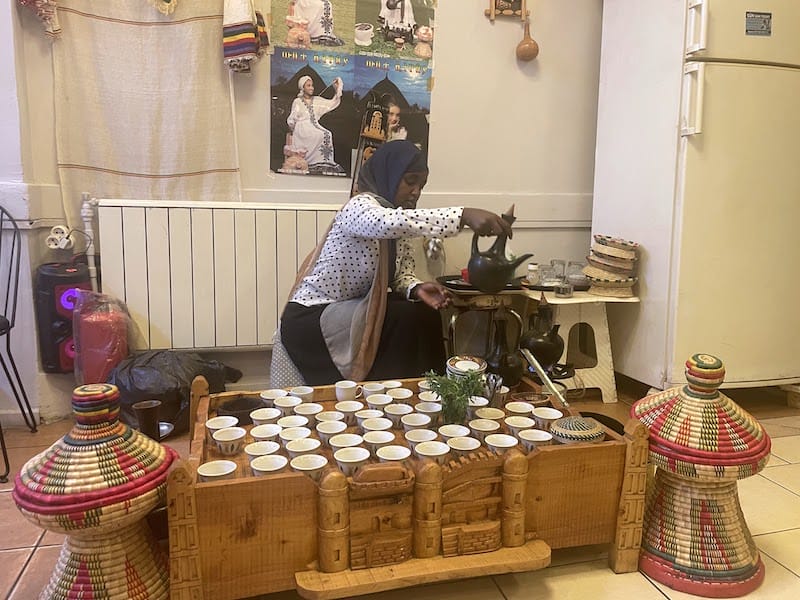
It’s buzzing on a summer evening, with customers sitting around small tables. Amharic, Oromo, Arabic, Turkish and English could all be heard. The smell of clarified butter, infused with basil and a special strand of Ethiopian cardamom, wafts from the kitchen, perfuming the restaurant and the side street. A young woman sits on the floor in the center waiting to begin the coffee ceremony, surrounded by posters of other women in snow white dresses doing the exact same. Large suitcases peek out from where they’ve been tucked away in the corner.
Binyam Behailu, the restaurant owner, greeted us with a boyish grin. His wife, Sara, manages the small kitchen in the back. Both moved to Istanbul from Addis Ababa nearly a decade ago. They originally managed a location across town that was part restaurant, part beauty salon, but decided to open up Mesob two years ago in Aksaray due to its location as the center of several concentric, colliding communities. Binyam and Sara’s philosophy is to treat everyone that comes through their doors like kin – the essence of a family-run business.
We ordered a meat combo plate that had a serving of pretty much every meat-based dish on their menu. Sara invited us into the kitchen to watch her cook. Almost every Ethiopian dish starts with the holy trinity of garlic, ginger and onion, and builds from there. Berbere, another staple of Ethiopian cooking, at face value looks just like a simple red chili powder. Although primarily made of red peppers, everybody has their own blend, and some mixes contain up to 26 different herbs and spices.

Binyam then brought out our combo platter, again flashing the same smile. Injera, the porous, slightly sticky national flatbread of Ethiopia, formed the base for our meal. Fresh injera is flown in from Addis several times a week. Teff, the super whole grain used to make the bread hails from Ethiopia. Naturally high in minerals and protein, it is gluten-free, offering an alternative to wheat.
Several wots, or stews, sat atop the injera acting as our canvas. We had alicha Minchet Abish, a braised ground meat yellow in color from the turmeric and ginger, as well as its alternative, quy Minchet Abish, which swaps out the turmeric for berbere spice, giving the sauce a deep red color and a sly heat that slowly builds in your mouth.
Ethiopian food is a communal affair, so everyone tears off a piece of the sour injera to soak up the sauces. We dabbed a bit of the orange-red mitmita mix on our injera before scooping up one of the stews, which provides a sharp, salty kick to any bite one chooses. We tried the dulet, sautéed liver and tripe with garlic, peppers, and onion; lentils, a mainstay, with meat; and two types of fir-fir, torn pieces of injera soaked in spices. Although typically served for breakfast, fir-fir can make surprise appearances at other times in the day, like on our plate for dinner that evening.
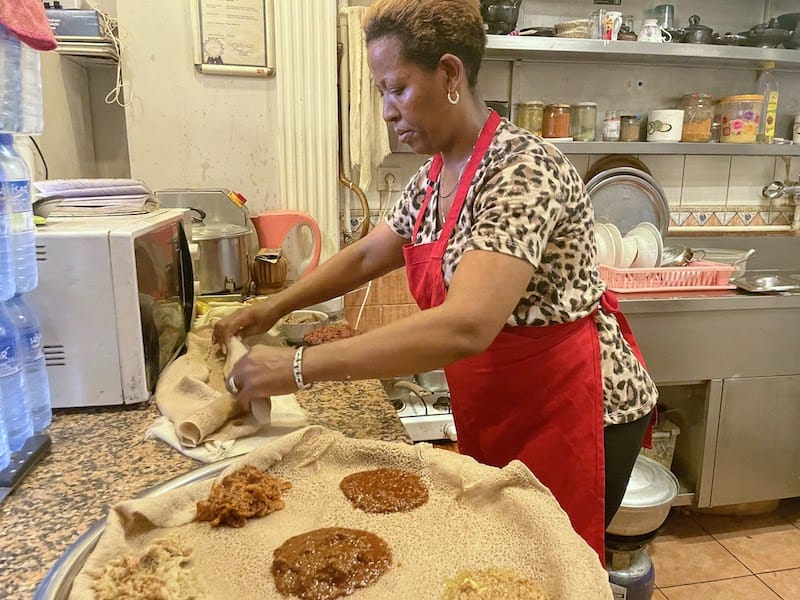
And, as opposed to Turkey’s meat-heavy cuisine – kebabs, doners, chicken wings and more – Ethiopian food has a large array of vegetable and vegan options. For more than a hundred and fifty days a year, Ethiopian Orthodox Christians abstain from animal products, in accordance with religious fasting. Binyam apologized for not joining us because he too was fasting that day. The restaurant also serves up injera with spaghetti, a fusion that dates back to Italy’s brief occupation of Ethiopia in the 1930s.
As we ate, Sara sat overlooking her customers. With streaks of bleached hair and a cheetah-print shirt, she tapped along to the guitar groove of Tariku Gankasi, a soldier-turned-singer that made one of the biggest Ethiopian hits of late. Over the speaker, he crooned over the country’s ethnic divisions. Late last year, combatants ended a two-year civil war that killed hundreds of thousands and displaced millions.
Binyam hurried around with large metal trays while taking orders by phone, selling a number of different items, including injera to-go, qolo – a beloved seed nut mix – and hair care products straight from Africa. He also does hawala, or money transfers, and can help in arranging residence permits. He strives to give the customer what they want.
“If you say you are out of something or can’t do something, then they might never come back,” he said. He literally goes the extra mile, recounting a time he took a metro ride two hours away to deliver food to a customer recovering from surgery in a hospital.
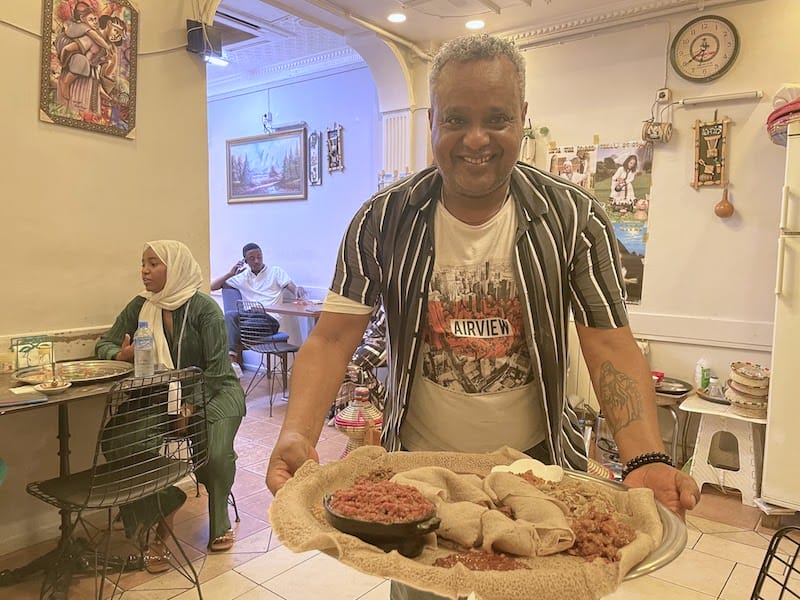
At the table, we turned our attention to the stars of the combo platter. Key wot, a red meat stew, packed a salty, umami punch with a slow burn. We also had a serving of kitfo, extra lean beef that becomes fatty by adding clarified butter and ends with the heat from the mitmita. It was greasy, delicious, and a must-try for anyone heading to Mesob.
One customer argued that the best part of the meal is actually at the end, when the various stews and sauces have melted into the injera that lines the tray. The dish may appear to be finished, but its flavor remains for you to pick at while you wait for your coffee.
The Ethiopian coffee ceremony is a core custom, as the country is considered the birthplace of the coffee plant and of coffee culture. The process can go from elaborate to over-the-top, as we have previously seen coffee-roasting ceremonies with frankincense, bitter herbs, popcorn, cotton, grass strewn across the floor and more, each making an appearance during the lengthy process. At Mesob, the ceremony is short and sweet, all the better for us to begin working down strong, bitter coffee from the tiniest of cups boiled in a black earthenware pot.
Over the meal, we noticed how the restaurant gave a space for the Ethiopian diaspora, the East African community and anyone else who cannot get enough of the spongy injera. And at the center of this universe stood Binyam, who tirelessly carried trays and fielded phone calls.
As we sipped coffee, Binyam’s cell phone buzzed with a call from a recent transplant to the city. The person said that a friend had put them in touch with Mesob. “Don’t worry. If you ever need a taste of home, just find me. I am on Google,” Binyam said reassuringly.
Joshua LevkowitzJoshua Levkowitz
Published on August 09, 2023
Related stories
April 11, 2024
OaxacaAs difficult as the last two years have been for food businesses, it has offered many establishments an opportunity to rethink how they do things and come back with a greater sense of purpose. Take the example of Oaxaca’s Oscuro Brebaje, a café that took a pause, only to emerge stronger and more inviting. Founded…
March 6, 2024
IstanbulThe fourth time was the charm when we finally were able to take a seat at Salepepe, a five-stool pizza bar in the exceedingly hip neighborhood of Yeldeğirmeni, located in Istanbul's Kadıköy district on the Anatolian side of the city. When we first went, the restaurant was closed due to selling out early, while the…
December 6, 2023
IstanbulErgenekon Avenue, the busy, one-way street that separates the Istanbul quarters of Kurtuluş and Pangaltı, is particularly bustling at the Osmanbey metro exit. For years now, the heavy foot traffic has outgrown its narrow sidewalks, peaking into an insurmountable throng at evening rush hour. On one side is an expansive walled Levantine Catholic cemetery, while…







































